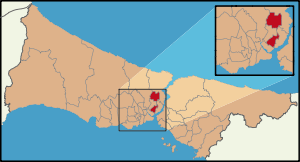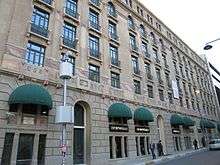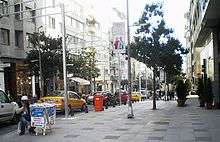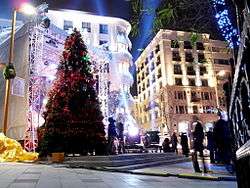Nişantaşı
| Nişantaşı | |
|---|---|
| Quarter | |
|
New Year's Eve decorations in Nişantaşı | |
 Location of Şişli in Istanbul | |
| Country |
|
| Province | Istanbul |
| District | Şişli |
| Time zone | GMT +2 |
| Area code(s) | (+90) 212 |
Nişantaşı is a quarter of the Şişli district on the European side of Istanbul, Turkey. It comprises neighbourhoods of Osmanbey, Teşvikiye, Maçka and Pangaltı.
Osmanbey is the heart of Nişantaşı and one of the most exclusive shopping and residential districts in Istanbul. Within Osmanbey area, Rumeli Street (Caddesi) is considered to the most exclusive street, equivalent of London's King's Street. Rumeli Caddesi include luxury brand stores, popular European-style cafés, pubs, restaurants and night clubs. One of Rumeli Caddesi's side street, Abdi İpekçi Street, It is considered as Turkey's most expensive shopping street.
History
Nişantaşı was settled by Ottoman Sultan Abdülmecid I in the middle of the 19th century. He erected two obelisks to define the beginning point and the ending point of the quarter. He ordered the construction of the Neo-Classical style Teşvikiye Police Station and the Neo-Baroque style Teşvikiye Mosque for a proper district, encouraging the citizens of Istanbul to settle here (hence the name Teşvikiye which means Encouragement in Ottoman Turkish).
The word Nişantaşı literally means Marking Stone in Turkish. Those stones are erected to mark the archery range records of the Ottoman archers and sultans. Some of these target stones, which are shaped like small obelisks and have Ottoman Turkish inscriptions on them, are still found on the pavements of Nişantaşı as monuments from the past. The inscriptions give information about the date, the shooter and the distance the arrow was thrown.[1]
Following the Balkan Wars of 1912-1913, many Turks from Macedonia, especially Thessaloniki (Selânik, which was an Ottoman metropolis until 1912) settled in the Nişantaşı quarter of Istanbul; including the family of the famous Turkish poet Nâzım Hikmet. Apart from the Turks, the quarter also had sizeable Greek, Jewish, Armenian and Levantine communities.
The building of Maçka Technical High School (Maçka Akif Tuncel Teknik ve Endüstri Meslek Lisesi) was originally constructed by the Italians to become their country's new embassy in Istanbul.[2] However, when Ankara became Turkey's new capital in 1923, the building was donated to the Turkish Republic and has been used as a school ever since.[2] There are three public primary schools on Nişantaşı Avenue (Nilüfer Hatun Primary School, Sait Çiftçi Primary School, and Maçka Primary School) and two public high schools (Rüştü Uzel High School, Nuri Akın High School.) Nişantaşı also includes the prestigious Feyziye Mektepleri Vakfı Işık Okulları (Feyziye Schools Foundation Işık Private Schools) which is a private school that has a kindergarten, primary school and high school in its campus. The school was established in 1885 as the Şemsi Efendi Primary School in the Ottoman city of Selânik (Mustafa Kemal Atatürk, the founder and first President of the Republic of Turkey, was a student of the Şemsi Efendi Primary School.) A number of the faculty buildings of the Istanbul University and Marmara University are also located in this area.
Today
Nişantaşı is today a fashionable shopping district and an affluent, secular residential area. The quarter forms the background to several novels by Nobel laureate Turkish novelist Orhan Pamuk, who is a local resident. Nişantaşı has the largest community of foreign residents in Istanbul after Taksim and Cihangir.
Image gallery
 Maçka Palas (1922) designed by Giulio Mongeri[3] houses the Emporio Armani, Armani Café and Gucci stores.
Maçka Palas (1922) designed by Giulio Mongeri[3] houses the Emporio Armani, Armani Café and Gucci stores. Art Nouveau style apartment buildings in Teşvikiye, Nişantaşı.
Art Nouveau style apartment buildings in Teşvikiye, Nişantaşı. Art Nouveau style apartment buildings in Teşvikiye, Nişantaşı.
Art Nouveau style apartment buildings in Teşvikiye, Nişantaşı. Millî Reasürans (National Reinsurance) building in Teşvikiye, Nişantaşı.
Millî Reasürans (National Reinsurance) building in Teşvikiye, Nişantaşı. Millî Reasürans (National Reinsurance) building in Teşvikiye, Nişantaşı.
Millî Reasürans (National Reinsurance) building in Teşvikiye, Nişantaşı. Teşvikiye Mosque in Teşvikiye, Nişantaşı.
Teşvikiye Mosque in Teşvikiye, Nişantaşı. Teşvikiye Mosque in Teşvikiye, Nişantaşı.
Teşvikiye Mosque in Teşvikiye, Nişantaşı. Teşvikiye Mosque in Teşvikiye, Nişantaşı.
Teşvikiye Mosque in Teşvikiye, Nişantaşı. One of the two archery stones in the courtyard of Teşvikiye Mosque in Teşvikiye, Nişantaşı.
One of the two archery stones in the courtyard of Teşvikiye Mosque in Teşvikiye, Nişantaşı.- Abdi İpekçi monument in Nişantaşı.
- Abdi İpekçi monument in Nişantaşı.
 Abdi İpekçi Street in Nişantaşı.
Abdi İpekçi Street in Nişantaşı.
See also
| Wikimedia Commons has media related to Nişantaşı. |
References
Coordinates: 41°03′06″N 28°59′29″E / 41.05167°N 28.99139°E
